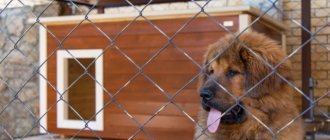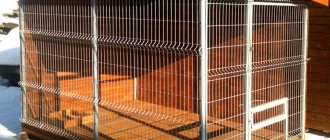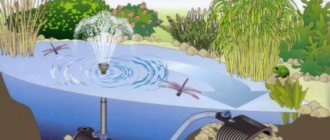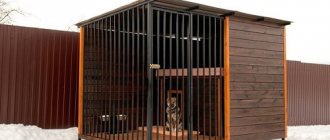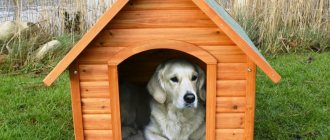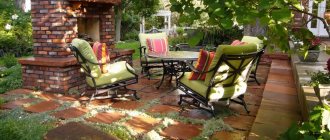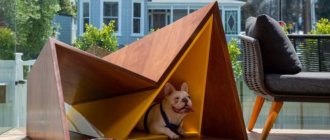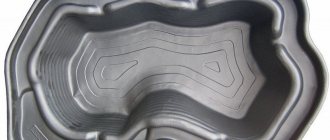SHARE ON SOCIAL NETWORKS
FacebookTwitterOkGoogle+PinterestVk
From this article you can learn how to choose a comfortable enclosure for a dog in an apartment with optimal characteristics: criteria for selecting materials, sizes and other parameters, taking into account the age of the animal and the conditions accompanying its maintenance. The text discusses the main types of these structures, their features and advantages, as well as recommendations for manufacturing.
An aviary for an apartment should be chosen based on the size of the dog breed and the necessary functions that the structure will perform
When you need an aviary: TOP-7 cases
An aviary is a special structure for the temporary residence of animals (in particular, dogs).
The structure can be made of metal, plastic or wood, with or without a roof. Many dog owners have been using these crates successfully for a long time. And for those who think that the enclosure is only intended for keeping large dogs outside, we can assure you that this is not the case.
There are several main reasons why owners of four-legged eared and tailed animals think about an aviary. So:
- There is a small breed of dog living at home : Yorkshire Terrier, Chihuahua, Russian Toy, Spitz, etc. These cute dogs always attract the attention of guests who want to stroke, touch and lisp them, and they generally don’t know where to hide from children. The enclosure will become their small fortress, their territory, which no one can encroach on.
- A puppy appeared in the apartment. He is interested in everything, he wants to run everywhere, sniff and chew with his small sharp teeth. To prevent anything harmful or dangerous from getting into your baby’s mouth, let him sit in the playpen for a while and play with his toys.
- The puppy needs to be toilet trained. This kind of “pen” is perfect for limiting the dog’s space. Therefore, only in this territory will she find a secluded place to relieve herself, and the owner will be able to put a tray or a diaper there. As a result, there will be no need to look for “surprises” throughout the apartment and remove them.
- The animal is sick or is in quarantine (for example, after vaccination). The enclosure, as a rule, is equipped with everything necessary: bowls for food and water, soft lining, toys, litter tray. There is a small area where you can take a walk. It is very convenient for owners to observe and care for the dog when it is in a certain place.
- The mother bitch is waiting for a new baby or is already feeding her cubs. Both she and the puppies need a place where they can calmly rest and gain strength without outside interference.
- The owner is absent and it is undesirable for the animal to run around the house. Then the aviary will be very useful. The structure will come in handy when carrying out repairs, general cleaning and even going out into nature. A portable structure of small size can limit the dog’s movement.
- There are other animals in the house. By placing the dog in an enclosure, you can easily exclude contact with other “residents”.
An apartment enclosure should become a place where a dog enters with pleasure, making sure of the person’s good intentions and comfortable conditions for staying there.
Calculation of the size of an enclosure for a dog based on basic parameters
The design of a cage is simpler than a kennel; two parameters are important for its construction - height and area. The first is determined by the height of an adult animal: standing on its hind legs, the pet should not rest against the roof. That is, the minimum height of the walls in the enclosure is 1.5 times the height of the animal. It is convenient if a person can enter the cage. Then you will need at least 1.6-1.8 m in height.
The area is also determined based on the height of the dog at the withers. A baby up to 50 cm will need at least 6 sq.m. , from 51 to 65 cm – from 8 sq.m. , more than 65 cm – from 10 sq.m. The width of the enclosure is taken out separately. It should be 1.5-2 times longer than the body length (from withers to tail) of the animal.
If you are planning a place for 2 dogs or a whole pack, the area is expanding (+3-4 for each dog), it is better to make a sectional division. The female needs a place to give birth (a vestibule, protected by walls on all sides, to protect newborn puppies from the cold), the male needs a spacious, strong kennel.
Forms and features of their choice
Today, many manufacturers offer a large selection of enclosures for installation in apartments. Among products of different shapes, you can always choose a model suitable for a specific room. The structures are produced:
- Rectangular.
- Polygonal.
- Square.
- Round.
It is clear that if there is enough free space in the house, then you can safely choose a round or polygonal enclosure, although rectangular structures are still considered the most popular.
What materials can enclosures for an apartment be made from?
You need to think in advance about what material the enclosure will be made of. Dog owners try to learn more in advance about the designs, the materials used to make them, the pros and cons, as well as the possibilities of independently reproducing the model they like. The materials from which fencing can be made are:
Metal
Metal apartment enclosures consist of several autonomous modules made of rods that are interconnected. The advantages of such structures are that they:
- Collapsible, which means they can be quickly folded, unfolded, reduced or enlarged depending on the growth of the puppy.
- They are easy to care for and do not absorb odors. It is enough to regularly wipe it with a damp cloth and disinfect it as necessary.
- Durable.
- Strong. They can be safely used outdoors.
Despite the large selection of finished products, dog lovers often make houses for their pets themselves, assemble enclosures or sew bedding. To create an aviary with your own hands you need to have:
- Material for forming the frame. It is desirable that it be a construction mesh with rods, and not a chain-link mesh. Since the cells of the latter are mobile, they can move and harm the dog.
- Metal rods or wood blocks to create support parts.
- Wire and pliers.
- Canopies on the doors and a couple of locks or latches.
It is worth considering that for puppies the sufficient height of the enclosure is 40-50 cm, for decorative dogs - at least 50-60 cm, and for larger dogs - about 1 m
The algorithm of actions is as follows:
- First of all, it is necessary to outline the contours of the structure (let it be a parallelepiped). If the frame is metal, you need to connect the rods together using welding or wire; if it is wooden, we knock together the bars with nails or twist them with screws.
- Cut pieces of the required size from the mesh, which will become the floor, walls and, if necessary, the roof of the structure. Fix the prepared parts on the frame.
- The entire perimeter of the enclosure is closed, except for one section where it is planned to install a door. The door is attached to the main structure with wire and by installing canopies.
- On the other hand, a latch is screwed onto the door, and loops are screwed onto the wall of the enclosure to secure the latch. That's it!
One of the options for creating an enclosure for an apartment is presented in the video below.
In the closed design model, a plywood sheet is placed on the floor. But before letting a dog into the enclosure, it is better to lay a dense but soft bedding on the floor.
It is advisable that the structure still does not have a roof, because... it can cause fear of enclosed spaces in a young dog.
Plastic
The choice of plastic enclosures is huge - they come in a variety of shapes, sizes, colors, additional elements, etc.
Undeniable advantages of the designs:
- Acceptable price.
- Complete set of separate modules.
- Easy to maintain.
- Ease of installation.
Plastic models are lightweight and have several components. For many dog owners, this is a great opportunity to show their imagination, experiment and create the most comfortable conditions for their pet. The fence can be divided into several sections or a couple of modules can be removed to expand the space, change the configuration of the enclosure and make it a stylish addition to the interior. And the fact that the products do not absorb odors and moisture, and a variety of detergents are suitable for them, only adds to their popularity.
But even such popular designs have their small disadvantages :
- Firstly, plastic models must be used very carefully for doggies who like to try everything and chew things for fun. This is due to the relative softness of the material used.
- Secondly, it is necessary to have suction cups that will firmly hold the enclosure attached to the floor, since this type of enclosure is very light in weight and any dog will move the structure from its place without any problems.
If you make your own plastic fencing , you need to stock up on:
- Profile pipe (round, rectangular or square).
- Tee fittings for pipes of the appropriate configuration.
- Scissors for cutting plastic pipes, corners.
We proceed according to the scheme:
- We cut pieces from the pipe, the length of which is the height of the future enclosure, and small pieces of 5 cm to connect the lattice.
- We use small tee fittings to connect to long pipes and get a finished section with a fence configuration.
- We connect the resulting walls together with plastic corners.
True, you will have to think a little about the method of attaching the door, but the final result will definitely please you.
All buildings are made taking into account the size of the dog. Inside the structure, the animal must be able to sit, stand, lie down and walk freely
Tree
Wood products always look very attractive, and they are also environmentally friendly. But for cute dogs, the most important thing is not the aesthetic appearance of the fence that marks their territory, but the fact that these planks can be chewed. This does not mean that they are completely impractical. Animal owners just need to be very careful and make sure that the animal does not break off a sharp sliver of wood with its teeth and injure itself.
It is believed that well-processed and sanded softwood is excellent for such structures. Many people choose wooden enclosures because they consider the material “warmer”, more familiar, and easier to work with. After all, by analogy with metal structures, you can make your own wooden enclosure. To work you will need:
- Bars, planks and plywood.
- Ruler, screwdriver, saw, screws.
- Canopies, latch or other latch, corners.
And it is best if, before starting work, a drawing, sketch or just a small sketch of the structure is made, which will indicate its dimensions and shape, and possibly its placement in the room. It is also necessary to prepare the wooden elements. They are impregnated with antiseptic impregnation (non-toxic) or a special varnish, which will provide good protection against rotting, mold or fungal attack.
And now - to the point:
- We assemble the frame. This is easy to do using wooden blocks and connecting them together using corners, screws or self-tapping screws. Taking into account the breed and size of the dog, one or two walls can be “sewn up”, making them solid.
- We install a kind of “fence”. To do this, we cut the planks of the same length, which is equal to the specified height of the structure, and simply attach them to the frame at the same distance from each other. Visually it is very reminiscent of a small fence. We assemble the remaining walls in the same way.
- In a similar way, but as a separate element, we assemble the door.
- Next, we fasten the resulting door and install locks on it for locking, and hinges on the wall in the appropriate place.
DIY aviary - ready! Now it remains to add some important little things so that you can safely let the dog into it:
- Gender should not be ignored. It would be nice to make it like walls, only solid. If this is not possible, you can take a sheet of plywood, chipboard or a piece of linoleum, and put thick fabric on top.
- It is important not to forget, when arranging the animal’s feeding area, about durable fastenings for bowls. Everyone knows that wood is highly susceptible to moisture, the structure is not so easy to dry, and it will begin to deteriorate very soon. Therefore, so that the dog, while playing around, does not turn over the bowls through carelessness or clumsiness, they must be securely fastened.
An apartment enclosure is the younger brother of an ordinary outdoor one and all the necessary conditions must be created in it: soft bedding, bowls, toys, a latrine (diaper, tray) and a place to rest
In the video you can see one of the options for creating a wooden enclosure with your own hands.
Chipboard
This material is well suited not only for floor equipment, as in the previous version, but also for creating a full-fledged apartment enclosure with durable walls. This type of fencing:
- Suitable for small breed dogs or puppies.
- It is easy to assemble.
- Has a long service life.
- Well washed, cleaned and disinfected.
- Safe for the dog both in terms of manufacturing materials and during use (no splinters or other similar injuries).
And creating such a “miracle” is not at all difficult:
- Chipboard slabs are cut in such a way that rectangles of the required height and length are obtained.
- The resulting walls are connected by installing internal bars. Corners are installed on top of the structure for fixation.
- Select a wall for the door.
- Stepping back slightly from the corner of the structure by 2-3 hinges, secure the door and install the locking mechanism.
Everything is quite simple and fast. And these factors sometimes become decisive when choosing fences.
Textile
For many dog owners, the ability to transport the enclosure and quickly install and dismantle it plays an important role. At the same time, they pay special attention to the strength of materials and the reliability of fasteners, because we are talking about the safety of their pets.
In this case we are talking about fabric enclosures made in the form of an awning tent. The frame of such products is made of durable plastic or lightweight metal (aluminum) pipes, the walls are made of polyester. For owners of babies such as Yorkies, Toys, Spitz or Chihuahuas, the designs described are simply a godsend, since their main advantages :
- A light weight.
- Waterproof floor.
- Easy to assemble and disassemble.
- Compact sizes.
- Affordable price.
- Convenience when traveling.
Of course, there were some drawbacks , although they are insignificant and fixable:
- The need for regular washing.
- Rapid wear of material with intensive use of the enclosure.
For those who decide to do their own tailoring, you should pay attention to a number of nuances:
- It’s good if the roof comes off, it makes it much easier to keep an eye on the animal.
- The bottom of the product can be reinforced to make it strong enough.
- Special fasteners (ties, Velcro) will help securely secure the enclosure, thereby protecting the pet.
- The presence of additional pockets for placing various small items, bottles and necessary accessories will greatly facilitate the care and maintenance of the dog.
For whatever purposes the enclosure is used (keeping, training or traveling to an exhibition), the dog cannot be closed for a long time or often, limiting its freedom. This can cause pain, loss of strength, or, conversely, cause aggressiveness.
Cardboard
It is rare to use thick cardboard to create enclosures for puppies and small breeds of dogs. Such designs are reminiscent of something from childhood, made with your own hands in labor lessons.
They are rarely used because they wear out quickly: they will have to be changed on average once a week. Plus, cardboard is easily susceptible to pets’ teeth, which can make it completely unusable in a matter of hours.
Interesting ideas for creating designs with your own hands
Having become familiar with the different types of structures, we can safely say that mobile, lightweight, folding enclosures can be made with your own hands using different materials. A solid arena can be constructed from wood, and a modular fence can be made from metal rods or a building mesh with fixed cells. Plastic pipes will be an excellent material for assembling a compact and very attractive structure.
Creating an enclosure for a four-legged friend is not only a responsible task, but also an excitingly interesting one. If you get together as a family and come up with new details and technical solutions, you can build a real “masterpiece.” In addition, different materials can be combined with each other: a wooden frame and walls made of steel mesh, sides - a lattice made of wood, a roof - transparent plastic, a metal fence - additional elements made of fabric.
Tips for selection and placement
Before purchasing or making an enclosure yourself, you need to decide on its future location. There are also several points that are important to consider:
- There should be no heating devices (batteries) or various household appliances in the immediate vicinity of the structure.
- The fence must be protected from direct sunlight and drafts. It is better if it is located in the back of a large room.
- They try to position the structure so that the animal, while in it, can observe most of what is and is happening in the room.
When choosing a design, you must pay attention to its safety:
- The manufacturing material must be harmless and in no way toxic.
- There should be no protruding parts or elements with sharp corners on the frame, walls and doors of the fence.
It is important to maintain cleanliness in the enclosure, since dirt not only causes an unpleasant odor in the room, but contributes to the occurrence of various diseases in animals
- The floor of the enclosure cannot be left uncovered; it must be covered with cardboard, linoleum, a blanket, plywood or chipboard (only in the area where the diaper is the toilet, nothing needs to be laid).
If the dog's owners have not thought in advance where to put the enclosure, then, after its construction, they will have to look for a place to install the structure . And it’s not at all a fact that there will immediately be a place for it or that it will fit into the interior. And in this case there are several tips:
- The metal fence is made of mesh and does not have a roof. It is unlikely that such an enclosure can be camouflaged in any way. But if you take this into account in advance and make it foldable, there will be no problem. Just fold it and put it away for a while.
- A small enclosure with a roof. You don’t always want such a design to catch your eye, so you can decorate it under a cabinet or table. To do this, you need to select the appropriate tabletop and place it on the roof (the main thing is that the tabletop is not huge, heavy, or, in general, monumental).
- The easiest way is to try very hard and find a secluded corner in the apartment that is suitable for installing an enclosure, where no one will disturb the dog, and the fence will not be discordant with the interior.
What does a dog playpen look like?
DIY dog enclosure: drawings and dimensions
A dog playpen resembles a kennel with comfortable conditions, usually without a roof. There she not only sleeps, but also eats and spends time. Such pet houses can be used in the interior. For example, an enclosure for a Chihuahua located in an apartment can be covered with a tabletop if necessary. Since dwarf dogs are small in size, they therefore require a low playpen. Therefore, it can easily be turned into a comfortable coffee table.
Metal enclosures resemble a cage, but it is easy to fold and put away when not needed. There are also canvas playpens, they weigh little and are easy to clean. In addition, they can be folded and transported, for example, to a summer cottage. Therefore, if you plan to move the cage, you need to think about the possibility of disassembling it.
Metal aviary
Material and height of the enclosure for different situations
The dog should be comfortable and calm in the enclosure. Therefore, below are some tips regarding design features in different situations:
- The bitch has whelped . A product up to 70 cm high without a roof is best suited. With this size and modification of the playpen, removing puppies from the enclosure will not be a problem, and cleaning and changing diapers can be done very quickly.
- Temporary content . As a rule, a small plastic or metal cage cage is used, closed on both sides and top, or a fabric playpen (tent) on a frame. They are inexpensive and easy to carry.
- “Miniks” or simply small breed dogs . As a permanent apartment structure, many dog owners choose plastic fences with a height of no more than 40 cm.
- The dog has grown and become medium sized . It is worth choosing a structure made of metal or wood, with side doors and a wall height (required) of at least 80 cm. The dog will exit through the door, since such a height will not allow it to jump out through the fence.
- Active pets . For especially frisky animals, owners, as a rule, choose structures with a pallet. Reliable, strong enclosures will not budge even under strong dog pressure.
- Decorative pets . Handsome pets require special attention and want everything around them to be beautiful too. And their owners don’t mind. An excellent option for a little friend is an expensive wooden enclosure, which, if desired, can become a highlight in the interior.
Photo gallery
Photo 1. The cage is decorated as a table
Photo 2. Puppies in an enclosure
Photo 3. Convenient metal enclosure
Photo 4. Aviary-cage for dogs
Photo 5. Original apartment aviary
Photo 6. Retriever in an enclosure
